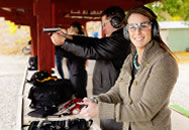
"What should I use to oil my gun?"
- Let's start with what you shouldn't use - WD40 or anything like it. WD-40 is a fine light duty oil and rust penetrator. Your gun is most likely blued. Bluing is a rust process. WD-40 removes rust. Over time the regular use of WD-40 on your gun will leave the finish bare metal! There is a product on the market called Tri-Flow that's a Teflon based lubricant with remarkable staying power. I've recommended this product for many years and have never been disappointed. Tri-Flow has repeatedly gained first place in comparison tests. It's only possible drawback may be its odor. It has a slightly sweet smell that may be detected by game animals in the field, although I have no evidence that this is so.
"What about grease?"
- Grease should generally be avoided. Most of it is wasted and only collects dirt. The dirt sticks to the grease and rapidly builds up deposits that creates a strain on the mechanisms. This strain can get so bad that the part either jams or breaks. Springs are especially prone to this situation. When I get this type of repair, it usually requires several hours with scrapers and solvents to dig the debris out of all the cracks and crevices it gets into. By the way, this advice goes for cooking grease (and oils) too. Not only does it present the same problems, but it smells really bad!
"I squirt some oil into my gun after hunting and then put it in my gun rack. Shouldn't this be enough?"
- A lot of good guns have been ruined this way. Squirting oil into a gun does nothing for cleaning it and is about the worst way to go about lubricating it. Most parts in a gun don't need oil. When you stand your gun up in your rack and all that excess oil slides down towards the back of the receiver, it slowly seeps into your gunstock creating oil soaked areas and stress cracks that will eventually split or break your wood apart. This excess oil also creates the same dirt collecting problems as grease. In cold weather all of this is aggravated as the oil or grease stiffens and turns into a very effective gun stopping glue.
"OK then, what should I do?"
Start with a clean, oil free gun:
- A little oil on slide rails and bolt assemblies.
- On shotguns with recoiling barrels lightly coat the magazine tube where the recoil spring and friction rings ride.
- A touch of oil in the trigger mechanisms and a light coat inside the receiver.
- Wipe down the exterior with a silicone impregnated cloths sold for about two bucks at most sporting goods stores to remove finger prints.
- DO NOT oil the inside of pistol magazines. The oil can contaminate ammunition and collect dirt, lint, dust, etc. which could keep your rounds from feeding properly.
- DO wipe down the exterior with a cloth and use a cotton swab to clean the insides.
"That's all?"
Almost. Some rules to remember:
- Never get any oil near the gas system of a gas operated firearm. The combustion gases that work the action will immediately turn the oil into a baked on sludge which will effectively shut down your weapon.
- Never over-lubricate. It can only trap dirt and damage your wood. Use just enough to help prevent rust and provide a little more slickness to your action. Believe it or not, most guns will work just fine with no oil at all.
- Take the time to learn how to disassemble and thoroughly clean your firearm. I can highly recommend the assembly/disassembly books from Gun Digest written by J.B. Wood. I have them all and refer to them regularly.
- If you do nothing else, every once in awhile pick up your firearm and look at it. Is rust forming anywhere? Does the action feel OK? Is it loaded? Did you check it when you picked it up? ALWAYS, ALWAYS check to see if the weapon you are holding is loaded. NEVER make any exceptions to this rule.











